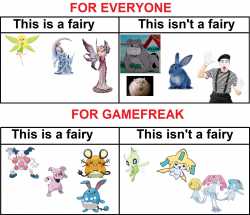>>51565026I understand but I don't agree at all. The problem is not that some pokemons that look like dragons are not dragons or vice versa, the problem is with the fairy type as a whole.
If you show your mother who only knows pikachu 30 pokémon of diverse typing, like fire, water, rock, dragon, even psychic or fighting, giving her a list of possible types and asking her to rank them, she will have - what - 70? 80% of correct answers?
But with the fairy type (and a little bit of the dark type - and still...) I'm willing to bet that it will fall in the 20% range.
Even if the types systeme clearly have some flaws (rock and ground which are very close, water and ice which overlap sometimes...) they are globally coherent and easily understandable for everyone.
Grass = plant pokémon.
Steel = metallic pokémon.
Normal = pokémon that have no particular type.
Even Dark = tricky, deceitful and/or thug pokémon.
But fairy ? What's a fairy? Pokémon inspired by "real" mythical and fairy creatures, like the moon-rabbit or a unicorn?
No, because there are lots of fairy pokémon not inspired by that, like Togepi, Gardevoir, Mawile or Sylvéon.
Well, ok, pokémon able to do magic? None of them are really related to magic in fact, or indirectly, and those that are (like Delphox) are rather psychic.
Small, pink, feminine and cute then? Besides the fact that "small and pink" is clearly not a good way to define a type, there are pink pokémon that are not fairy and fairy pokémon that are not cute or pink, like Galarian Weezing.
Or maybe a mix of all of the above? Maybe, but this makes for a confusing type, with ill-defined contours, and of which it is mostly impossible to determine at a glance whether a pokémon is part of it or not (the trio of elf pokémon is a good example). It's just a type that was invented for game balancing reasons, which may make more sense to the Japanese (I don't know) but to any normal westerner, it doesn't make much sense.

